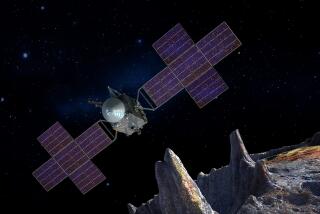‘Oumuamua, the mysterious visitor from outside the solar system, is a comet after all
- Share via
The interstellar identity crisis is over: ‘Oumuamua, that strange, somersaulting space rock from far outside our solar system, is a comet after all, astronomers say.
The conclusions described in the journal Nature solve a months-long mystery as skywatchers sought to determine the true nature of this strange sample from a different sun.
‘Oumuamua, named for the Hawaiian term for messenger or scout, was discovered on Oct. 19 by the Pan-STARRS1 telescope system, which searches for nearby objects that could pose a threat to Earth.
Telescopes around the world began tracking ‘Oumuamua (formally named 1I/2017U1), which turned out to have an extremely eccentric path and seemed to arrive from above the plane of the solar system. It did not swing close to any of the eight planets and didn’t seem to have a closed orbit at all.
The object, astronomers concluded, must have been born around another star.
‘Oumuamua was roughly pencil-shaped: its roughly quarter-mile length was about 10 times its width, and because it brightened and dimmed regularly by a factor of 10, scientists knew it must be twirling like a baton as it sped past the planets.
At first, the Minor Planet Center classified ‘Oumuamua as a comet — these icy missiles are more likely to be able to make a star-crossing journey than asteroids would, and ‘Oumuamua’s surface reflectivity looked pretty comet-like too.
But that classification was withdrawn because ‘Oumuamua seemed to be missing a telltale (or perhaps tell-tail) feature: the coma.
Comets originate in the cold, distant reaches of the solar system, which means they can hold a lot of ice in their bodies. As their highly elliptical trajectories take them near the sun, some of that ice starts to sublimate, forming a trailing cloud of gas and dust that is illuminated by sunlight.
‘Oumuamua had no ghostly coma. Was it a comet or an asteroid?
“We expected that the very first ISO [interstellar object] seen should be a comet,” study coauthor Karen Meech, an astrobiologist at the Institute for Astronomy in Hawaii, said in an email. “Comets form in the outer solar system where it is cold and there should be a lot more material. If the first ISO seen is an asteroid that would be unusual and would suggest that there should be a lot more material out there than we were expecting.”
To find out, an international team of scientists assembled a large set of images, taken from the object’s discovery to Jan. 2, at which point the comet was about 2.9 astronomical units (or Earth-to-sun distances) away from the sun and still heading out into space. The dataset showed ‘Oumuamua at 177 different positions as seen from various ground-based telescopes and 30 as seen from the Hubble Space Telescope.
The scientists found that ‘Oumuamua’s path could not be explained entirely by the gravitational tug of the sun, the planets, the moon, Pluto or any of the 16 largest asteroids in the main belt that lies between the orbits of Mars and Jupiter. They ruled out several possible explanations, including the pressure from sunlight, the thrust generated from emitting thermal energy (known as the Yarkovsky effect), friction or drag-like effects or even sudden collisions. They also ruled out the idea that this object was highly magnetized and thus influenced by the solar wind, or that it was fragmented and made out of multiple bodies, which would have theoretically altered its trajectory.
Instead, the scientists found that the best explanation for the altered path would in fact be from out-gassing – the kinds of emissions that could theoretically produce the tail of a comet.
There might be a reason that ‘Oumuamua does not have a visible coma even though it has released enough gas to alter its trajectory, the scientists said.
“The lack of observed dust lifted from the object by the hypothesized cometary activity can be explained by an atypical dust-grain size distribution that is devoid of small grains, a low dust-to-ice ratio or surface evolution from its long journey,” the scientists wrote.
Comets are essentially frozen fossils from a star’s birth, holding the volatile chemicals and other elements that were present during stellar infancy. Because of this, ‘Oumuamua’s possibly unusual chemical and dust properties could offer a window into the nature of its home star.
“This work shows that although ‘Oumuamua looks familiar there are differences that relate to its birth in a solar system far from our own,” the authors wrote.
The scientists already picked up on some tantalizing hints, Meech said.
“The amount of water we predicted should be coming off the comet suggested we should have seen [small amounts of cyanide] if ‘Oumuamua had the same chemistry as comets in our solar system,” said Meech, whose work on the paper included leading the Hubble observations of the comet. “So I think it is very interesting that we are getting a look at possible chemical differences between solar systems.”
But there’s only so much that can be seen from a distance, they added, pointing to the need to get a closer look at such interstellar samples. (Even though ‘Oumuamua is leaving our neighborhood, there may be other immigrant space rocks that could potentially be studied in the future.)
“In situ observations would be essential to reveal unambiguously the nature, origin and physical properties of ‘Oumuamua and other interstellar objects that may be discovered in the future,” they wrote.
Follow @aminawrite on Twitter for more science news and “like” Los Angeles Times Science & Health on Facebook.
MORE IN SCIENCE
The surprising thing the ‘marshmallow test’ reveals about kids in an instant-gratification world
Extinct species of gibbon discovered in an unlikely place — the tomb of a Chinese noblewoman
Koko, the gorilla whose sign language abilities changed our view of animal intelligence, dies at 46
UPDATES:
8:45 p.m.: This article was updated with comments from Karen Meech.
This article was originally published at 10:55 a.m.







